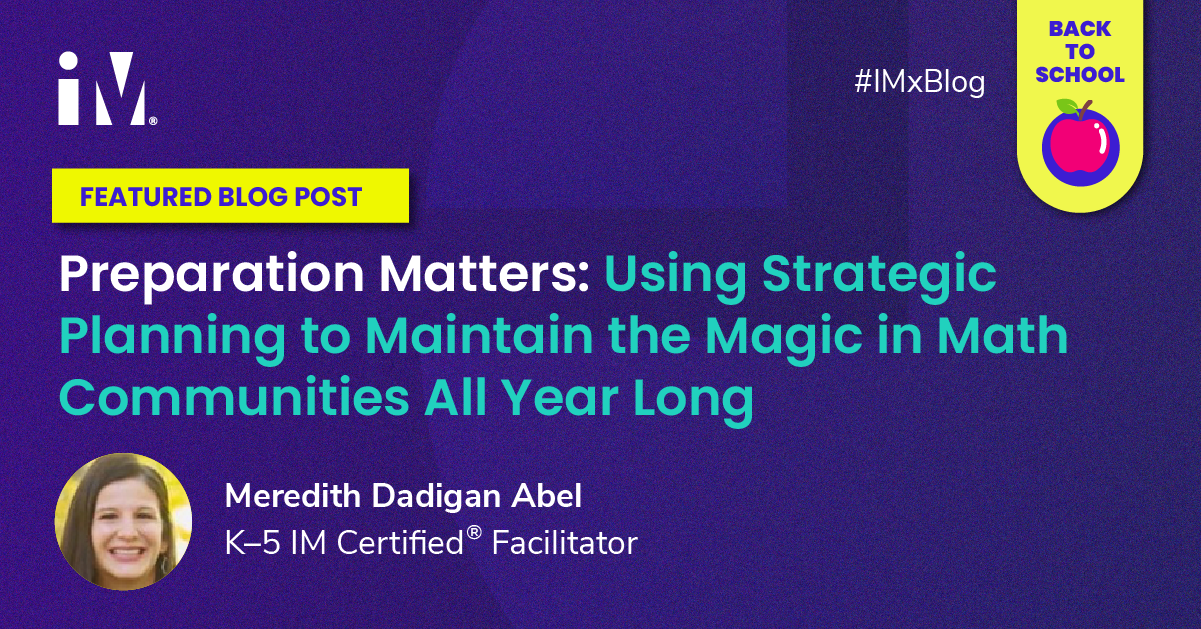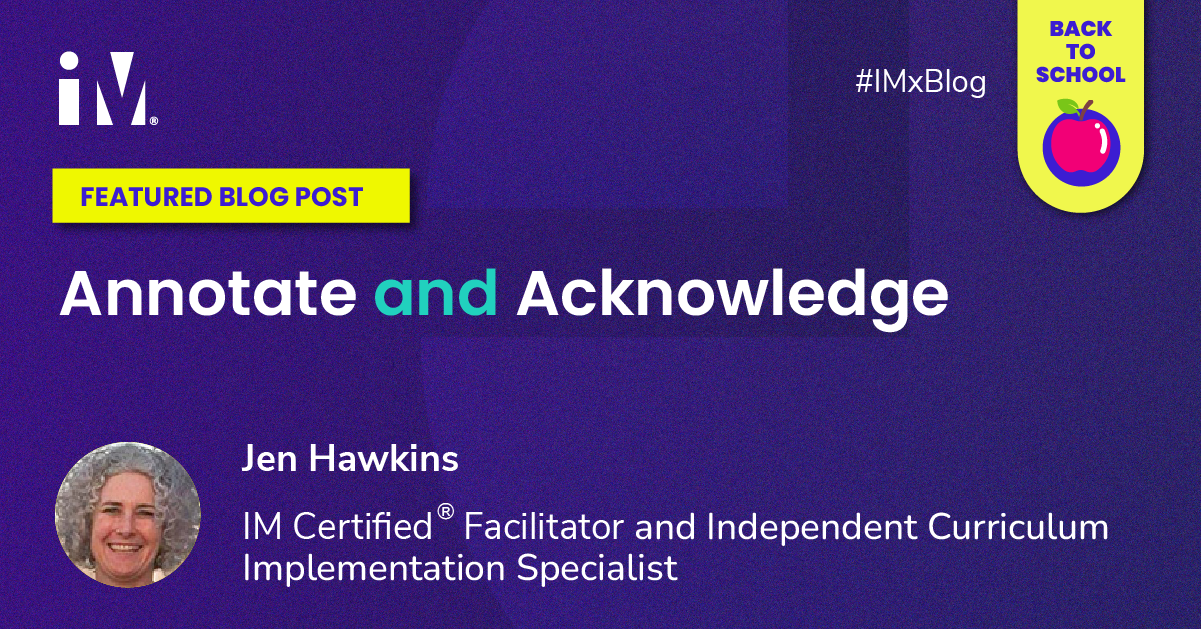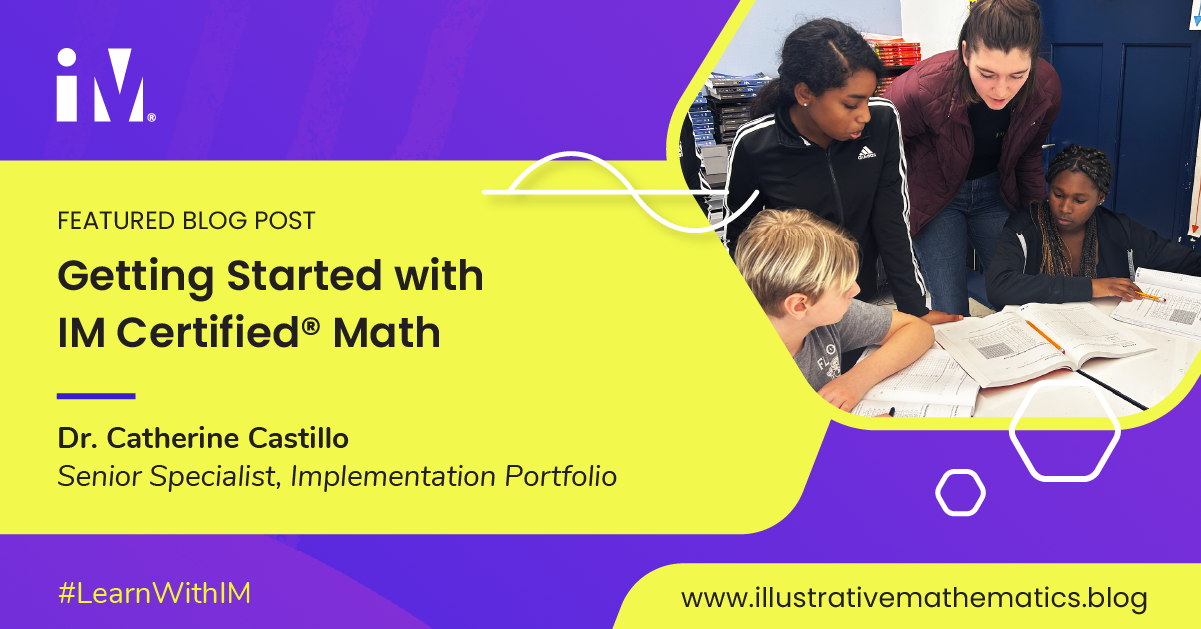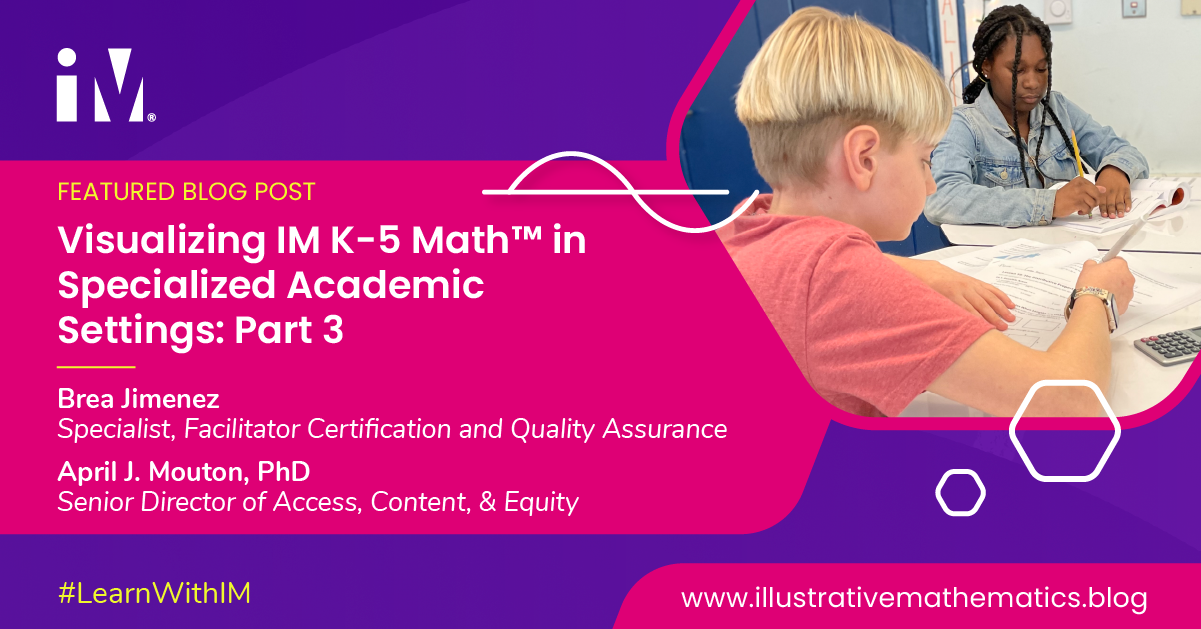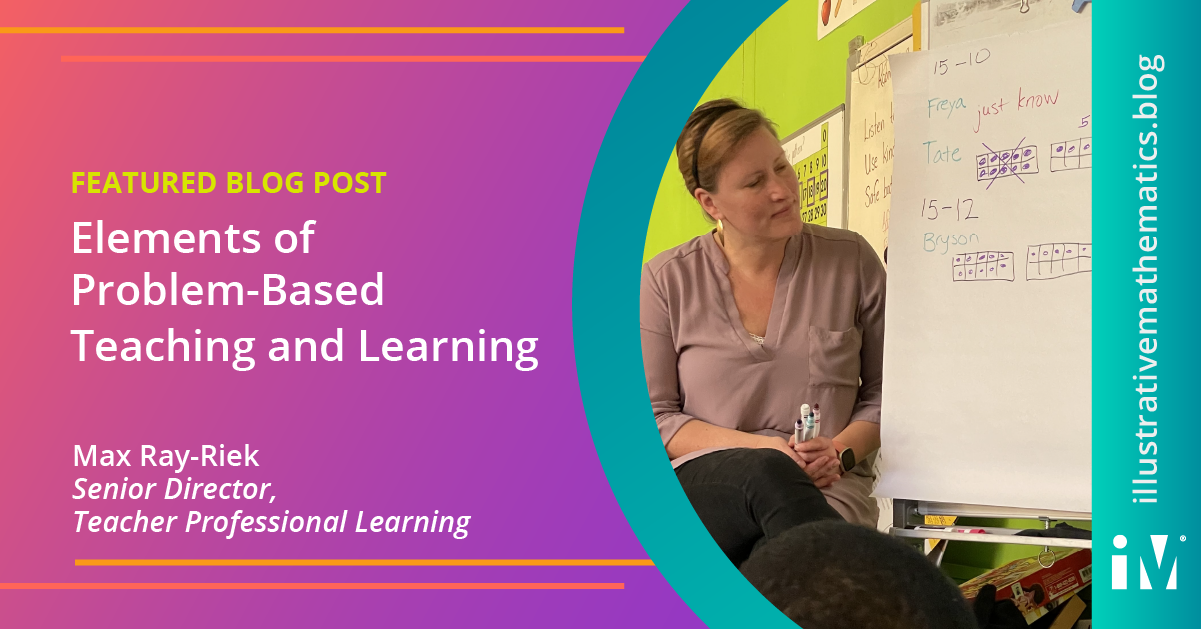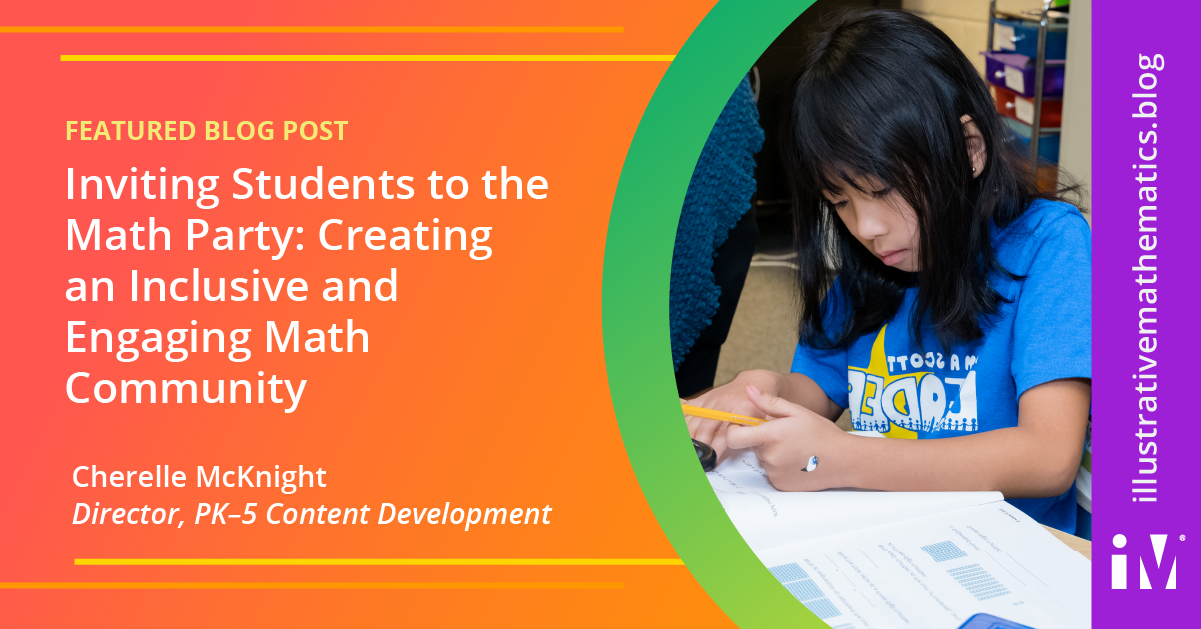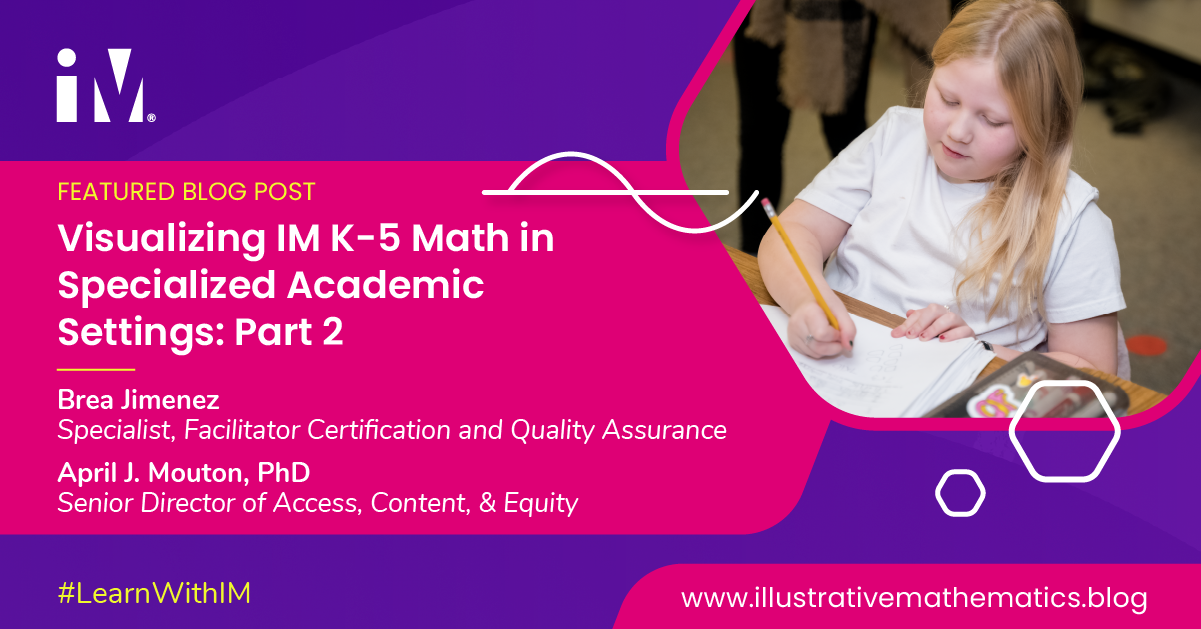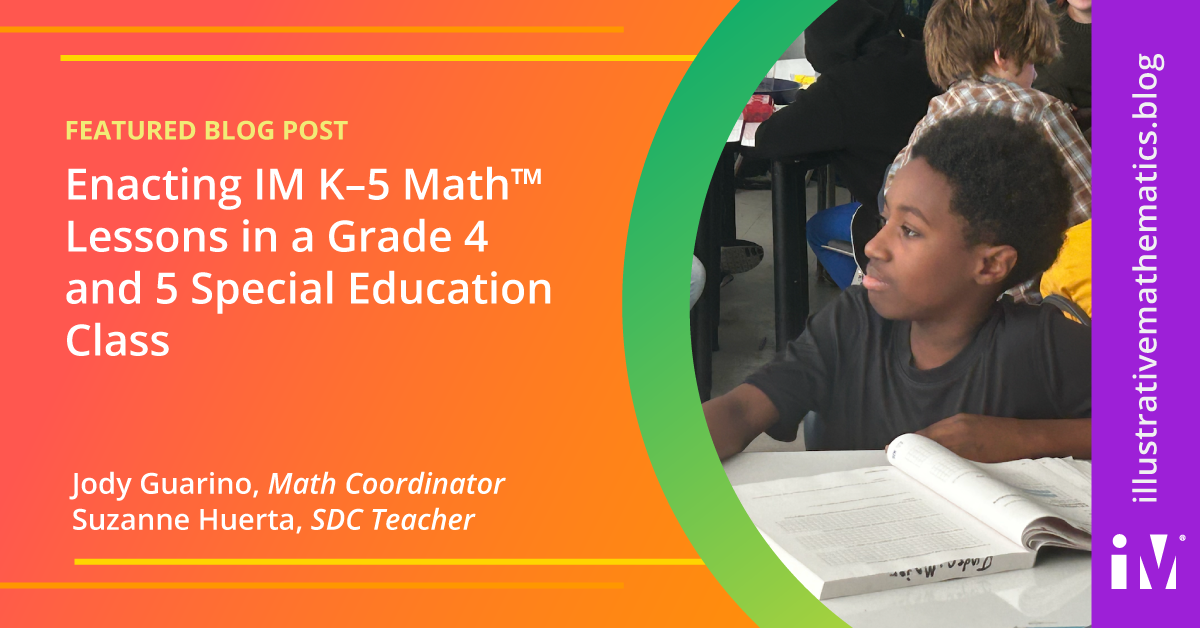IM Certified® Blog
Preparation Matters: Using Strategic Planning to Maintain the Magic in Math Communities All Year Long
By Meredith Dadigan Abel, K-5 IM Certified® Facilitator When teachers come back from summer break, there is a magical feeling in the air. For me, it’s like the feeling that accompanies the first snowfall of the season....
Annotate and Acknowledge
By Jen Hawkins, IM Certified® Facilitator and Independent Curriculum Implementation Specialist As I sat at the table in the back of the room, I watched the teacher reveal an image connected to the lesson’s warm-up. She told...
Getting Ready for 2024–2025 Back to School with Illustrative Mathematics
By the IM Team Welcome to the 2024–2025 school year! As we gear up for another exciting year of learning and growth, Illustrative Mathematics is here to support you every step of the way. This year, we are more committed...
Getting Started with IM Certified® Math
By Dr. Catherine Castillo, Sr. Specialist, Implementation Portfolio Are you leading IM implementation at your school or district and want to ensure an organized and thoughtful rollout? With the upcoming launch of IM® v....
Math Successes Multiply with a Growth Mindset
By Dr. Elisabeth O'Bryon, Chief Impact Officer and Co-Founder of Family Engagement Lab and Toka Hussein, K-5 Curriculum Specialist at Illustrative Mathematics Illustrative Mathematics (IM) and Family Engagement Lab (FEL)...
Visualizing IM K-5 Math in Specialized Academic Settings: Part 3
By Brea Jimenez, Specialist, Facilitator Certification and Quality Assurance and April Mouton, Senior Director, Access, Content & Equity Special education is intended to provide bridges between challenges and triumphs...
Leveraging PLCs to Maintain the Magic in Math Communities Throughout the Entire Year
By Meredith Dadigan Abel, K-5 IM Certified Facilitator When teachers and students come back from spring break, spring fever is in the air, and classroom routines may falter. While teachers have spent the entire year setting...
Elements of Problem-Based Teaching and Learning
By Max Ray-Riek, Senior Director, Teacher Professional Learning Our vision at IM is a world where all students know, use, and enjoy mathematics. Educators in our IM Community work toward this vision in classrooms day after...
Inviting Students to the Math Party: Creating an Inclusive and Engaging Math Community
By Cherelle McKnight, Director, PK-5 Content Development At one of my former schools, students who passed out birthday party invitations had to invite their entire class. While I disagreed with how the policy was...
Visualizing IM K-5 Math in Specialized Academic Settings: Part 2
By Brea Jimenez, Specialist, Facilitator Certification and Quality Assurance and April Mouton, Senior Director, Access, Content & Equity IM believes in a world where all learners know, use, and enjoy mathematics. We...
IM Kickoff Message for 2024
A Look Back and a Look Ahead By Bill McCallum, IM Co-Founder and CEO Hello there, and welcome to 2024! I hope that you have had time to relax and recharge in preparation for all of the excitement that this year will bring....
5 Steps We Must Take To Truly Create An Inclusive, Representative, and Equitable Society
In her interview with Yitzi Weiner for Authority Magazine, Odalis Amparo (Illustrative Mathematics’ Professional Learning Specialist) emphasizes the significance of culturally responsive and equitable mathematics education....
Reinforcing Conceptual Understanding after Assessments
By Greta Anderson, CEO of Greta Anderson Consulting, LLC and IM Certified Facilitator There’s a common misconception that has surfaced on a checkpoint, but no additional minutes or days to reteach. How will this impact...
Making math relevant starts with valuing your students’ experiences
Anita Crowder, Director of Impact at Illustrative Mathematics, reimagines math education by emphasizing the importance of students' own experiences and existing knowledge. She challenges the traditional view of students as...
Visualizing IM K–5 Math™ within a Dream Team of Supports
By April Mouton, Senior Director, Access, Content & Equity and Brea Jimenez, Specialist, Facilitator Certification and Quality Assurance The Gradual Release of Responsibility approach to learning mathematics—I do, we...
Introducing IM 360: Taking Students Around the World of Mathematics
By William McCallum, IM CEO You asked, we listened, and now, we are preparing to deliver! I am excited to tell you today about our new curriculum, IM 360, which was developed based on your thoughtful feedback. IM 360 is the...
Cultivating Joy in the IM Classroom
By Deborah Peart, Founder and CEO of My Mathematical Mind If we want students to Know, Use, and EnJOY mathematics, it begins with teachers. Joyous math experiences are about more than having fun and keeping students happy...
Building Thinking Classrooms with the IM Curriculum
By Adrienne Baytops Paul, Math Specialist, UnboundEd, COO of My Mathematical Mind, and former Middle School Teacher The 14 Practices of Peter Liljedahl’s Building Thinking Classrooms (BTC) complement the Illustrative...
Getting Ready for 2023–2024 Back to School: Getting to Know Your Curriculum
By the IM Team And just like that, school is back in session! Whether you are implementing the IM curriculum for the first time or getting a fresh start as you experience year two or three, the beginning of the year is the...
The IM Experience—Let’s All Know, Use, and Enjoy Mathematics
By Dionne Aminata, IM Senior Director, Strategic Initiatives As a fully remote organization, the IM team gets a lot done working behind the screens. Now, with IM K–12 Math in full swing, many of us are stepping away from...
Getting Ready for 2023–2024 Back to School: Building a Math Community
By the IM Team As summer winds down, we understand that you are not rushing toward the finish line of your summer break. Hopefully, there have been many lazy days, trips or adventures, and time spent with family and...
Planning for Conference Season: Making Time to Connect and Learn
By Dr. LaToya Byrd, IM Senior Director, Professional Learning Implementation and Talent The excitement is building. Can you feel it? Conference season is almost here! Math conferences create opportunities for educators to...
Collaboration Rather Than Competition: Creating Collaborative Classrooms Through Illustrative Mathematics
By Eric Partridge, IM Certified® Facilitator I don’t have many memories from elementary school. The one memory I have from elementary math is from playing Around the World. The object of this game was to answer a...
Enacting IM K–5 Math™ Lessons in a Grade 4 and 5 Special Education Class
By Jody Guarino, Math Coordinator and Suzanne Huerta, SDC Teacher What does it look like for everyone in a school to learn together? This question, posed by Elham Kazemi, pushes us to consider that we, adults and educators,...
